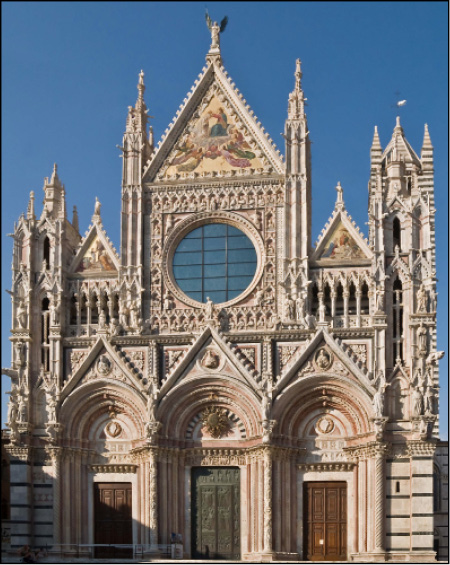
Fig. 11
The Cathedral of Siena
Although the cases mentioned here are eloquent enough, we wish to present another: that of the Cathedral of Santa Maria Assunta in Siena. The construction of this splendid example among the best examples of Romano-Gothic architecture began in 1229. Between the years 1258-1285, the direction of the building was entrusted to the Cistercian monks of San Galgano, who called Nicola Pisano and his son Giovanni to Siena. At the beginning of the XIV century Siena was at the zenith of its prosperity and the Cathedral’s proportions appeared unworthy of the splendour of the Republic: it was decided then to construct a new and grand Cathedral, of which the existing church would be only a transept. Lando di Pietro was put in charge of the project in 1339, but the plague in 1348, and several wars with bordering States brought the situation from prosperous to critical and the ambitious project was definitively abandoned. Work was then continued on the original Cathedral, and was finished only in 1382, about a century and a half from the beginning of the work.
With respect to our current theme of interest, our attention for this church is directed towards the Cathedral Pavement. Considered by Vasari “ the most beautiful, great, and magnificent pavement ever made ”, the pavement of the Cathedral of Siena is entirely covered by a series of marble inlays, which seem the tiles of a great mosaic, realized between 1369 and 1547 by more than forty artists 116 , the most famous of which was perhaps Bernardino di Betto, called il Pinturicchio. Their number is highly significant for us: they are, in fact, 56. What does this number tell us? It is, obviously, the number of the Minor Arcana...
In this case as well, it is not yet possible to prove a connection with the Tarot. However, if there were other signs, a correlation could be found.
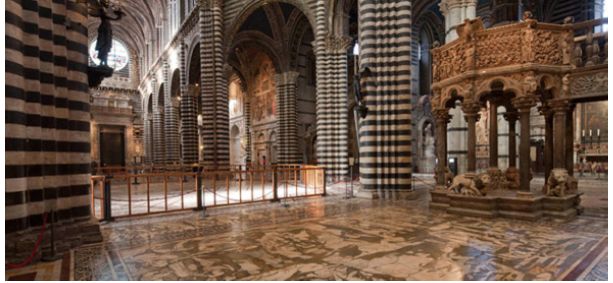
Fig. 12
Paving of the Cathedral
The first great painting (fig.13), exactly facing the principal entrance, may amaze us for its subject, having apparently little to do with the Christian Church. Here indeed the figure of Hermes Trismegistus dominates, a mythical and symbolical figure believed to be the incarnation of the Egyptian God Thot (corresponding to the Greek Hermes and the Latin Mercury), inventor of writing, of Alchemy, and of all science which from him took the name Hermetic.
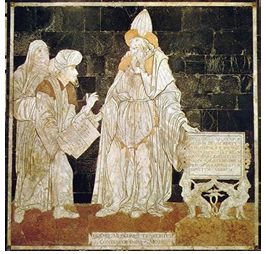
Fig. 13
Hermes Trismegistus
Hermes is represented as a venerable figure, his right hand extending a volume to another personage, behind whom appears a third figure of youthful aspect. With his left, instead, he touches a large stone tablet held up by two sphinxes with tails entwined, upon which are inscribed some verses of Asclepius and of Pimander, two ancient books attributed to Hermes, part of the so-called Corpus Hermeticum . At the base of this mosaic, a scroll is engraved HERMES MERCURIUS TRISMEGISTUS / CONTEMPORANEUS MOYSE, (Hermes Mercury Trismegistus, contemporary of Moses). This is an important fact, as esoterists have always associated the figure of Hermes Trismegistus with that of the ninth blade of the Tarot, the Hermit, with which he has also a certain phonetic assonance. Thanks to the “ Codes of dualistic symbols ” (of which we spoke before) it is possible to demonstrate that this identification is perfectly correspondent, as the Hermit also represents Thot. The most amazing aspect is that we may ascertain, always through Codes, a complete analogy with Moses as well, with which we will, given its immense complexity, in a future work. Therefore, the Hermit also represents Hermes Trismegistus; and this fact explains another subtle singularity of the original name on the cartouche, l’Hermite . Why is there an H at the beginning when in French the correct term would be Ermite ? This letter, furthermore, larger than the others (a confirmation of its importance), is a direct testimony of this identification, as it consents the association of the Hermit directly to the Greek Hermes, none other than the Egyptian Thot.
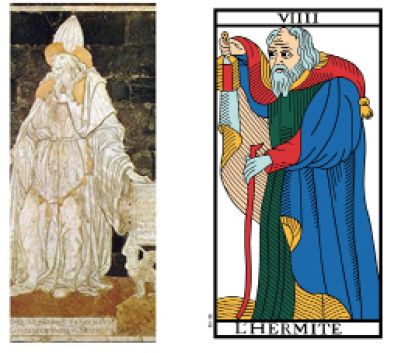
Fig. 14
Hermes and the Hermit
We may be permitted to ask ourselves why, in a Christian cathedral which, according to the logic of the official church, should be quite bare of this sort of iconography, Hermes Trismegistus is represented, in the first tile itself, precisely at the entrance, the most significant location in the entire building? In order to entirely understand the intentionality of this disposition, it is necessary to simply remember that the secular esoterical tradition, however nebulous and nonsensical, maintains that the Tarot is an invention of his, already known under the name of the aforementioned Book of Thot . 117 Then it cannot be another coincidence that in the first tile is illustrated, precisely as on the cover of any book, the author of the remaining “55”...? Apart from the correctness of the theory on the origin of the Tarot, it is undoubtedly an explicit and voluntary modality for encoding the relationship between the symbolic message on the pavement and that of the Icons. Once we have understood this parallelism, we comprehend why, in the mosaic, behind the shoulder of Hermes, there is depicted a sphinx (fig. 13). We find this symbol, in fact, which is present also in the card of the Wheel of Fortune when the cards are correctly positioned according to the scheme of the 3x7 Diagram, thanks to the natural numerical sequence, exactly behind the shoulders of the Hermit, as in the Cathedral!
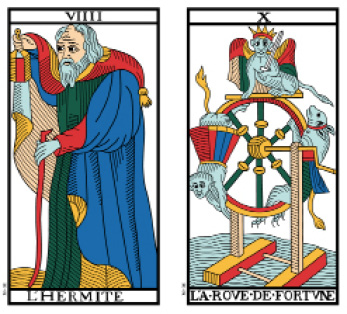
Fig. 15
Hermit and Sphinx (at the top of the Wheel)
With this perspective, then, we also understand the reason for the presence of another tile, for centuries considered an implicit reference to the Arcana. In it, a wheel with spokes imagined in movement, dominated by an imposing enthroned emperor and with three personages attempting to ascend and descend. The following illustrated figures will aid in verifying that not only the overall sense of both leads back to the representation of changeable human destiny, but that they undoubtedly resemble each other .It is not by chance that the sphinx, as might a king-emperor, wears a crown on its head...
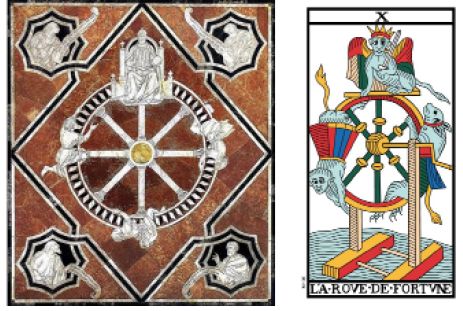
Fig. 16
The two Wheels
Thus, if it is true that the portrait of Hermes Trismegistus (in any case, we repeat, totally extraneous to the area of Christian symbology) was perhaps made in 1488 by Giovanni di Maestro Stefano, the second mosaic is datable to the first years of the 1400’s, the work of Domenico di Niccolò, master builder of the works of the Duomo from 1413.
In these circumstances, as well are we obliged, as dictated by the historiography of recent years, to hypothesize that the symbolism present in the Tarot was copied later? Such obstinacy seems completely inadequate to us, also because this pavement was created as a sort of great educative fresco, a teaching by means of images, in a manner in every way similar to the symbolical system of the Tarot itself. We know that this evidence is not sufficient by itself to demonstrate in a definitive manner the correctness of the hypotheses that we affirm. In any case, this is not our objective, which, as we have repeatedly declared, is to demonstrate the presence of a Coded Structure, the sole true custodian of the significance of the Icons . However, it is certainly adequate to call into question the traditional historical point of view and create some doubt in those who categorically refuse the possibility that the Tarot is truly the depositary of an extremely remote Tradition, a common source of inexhaustible spiritual richness.